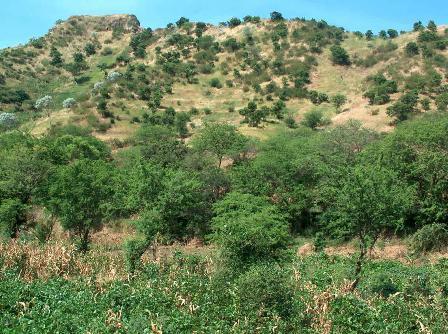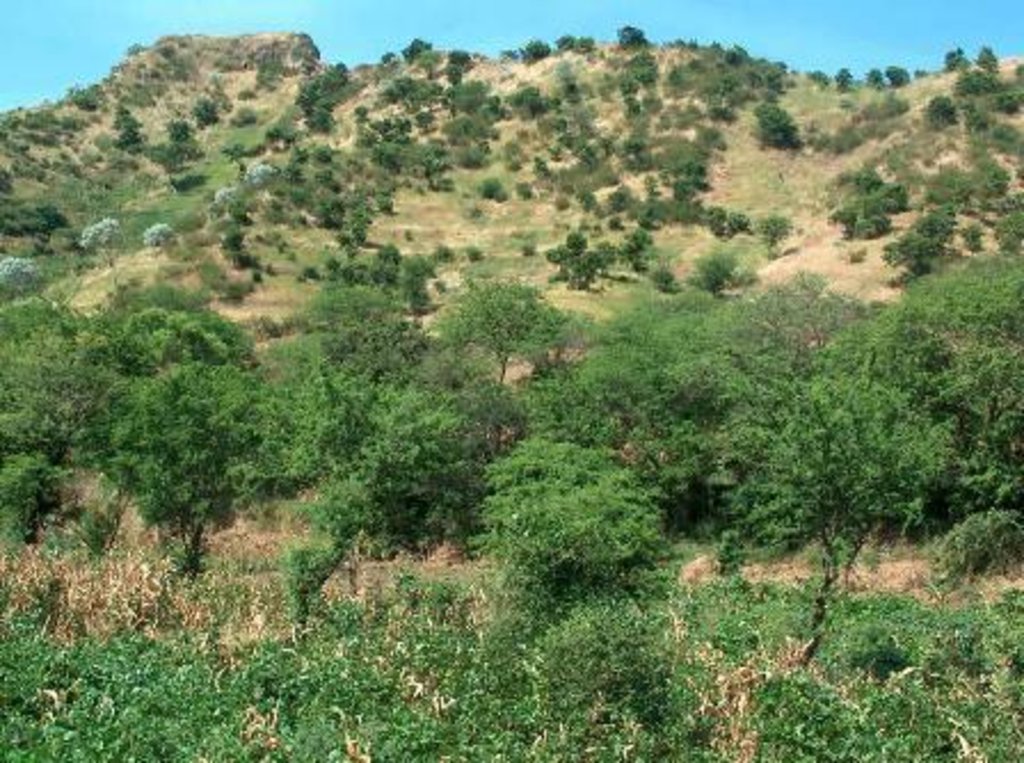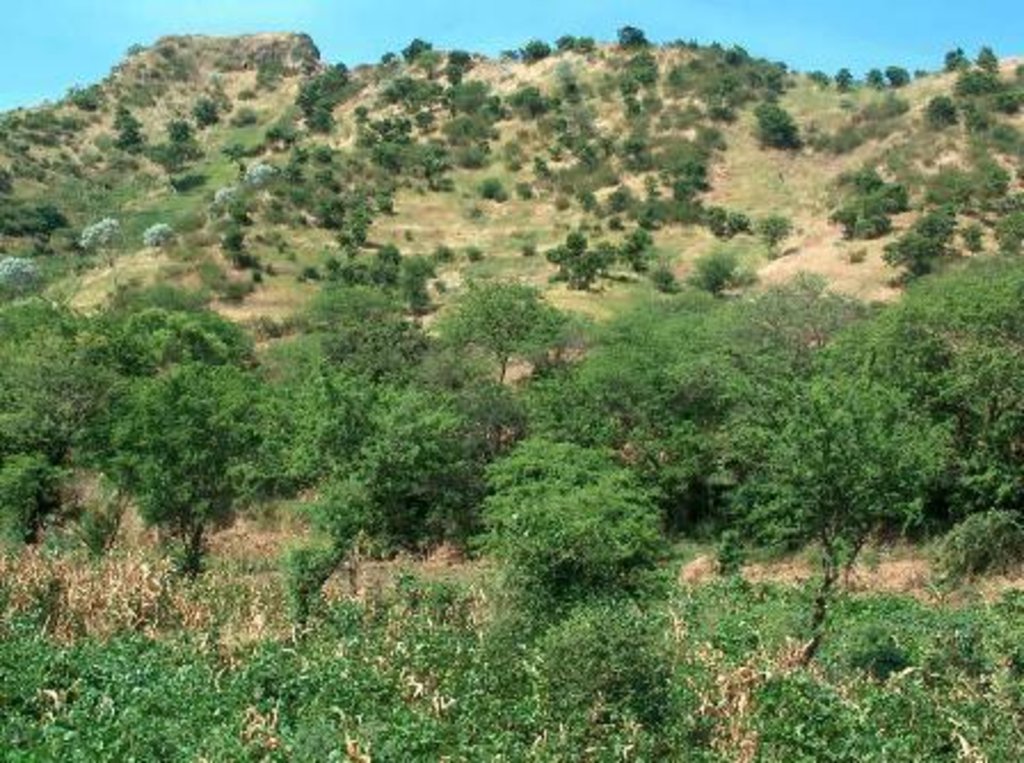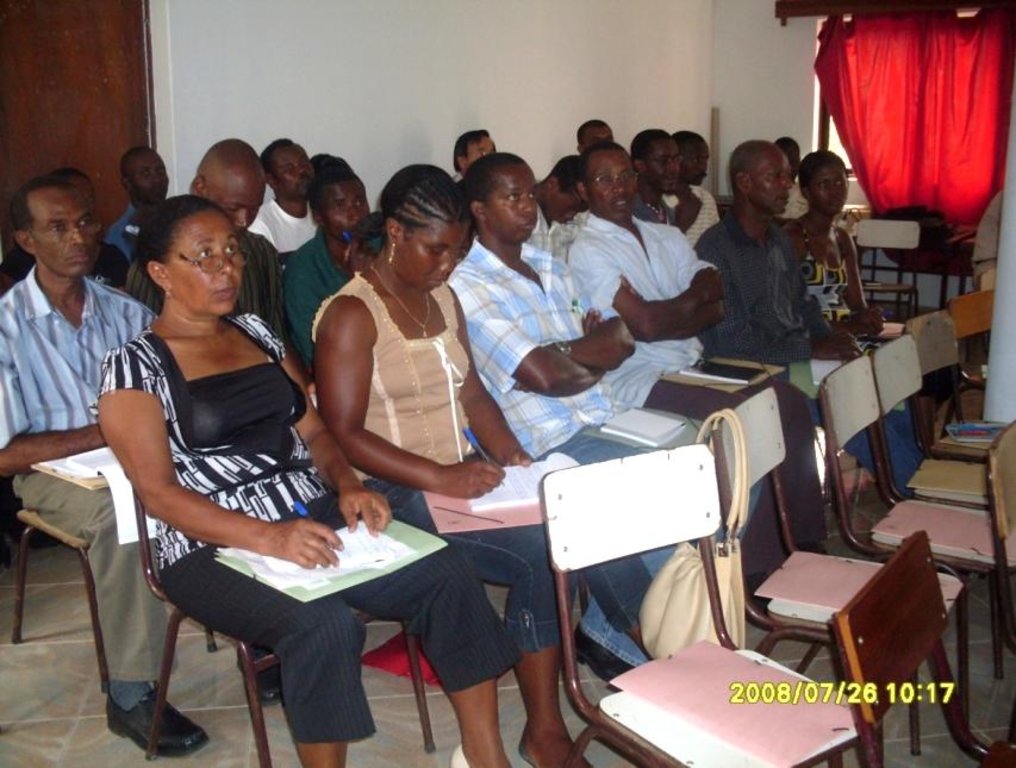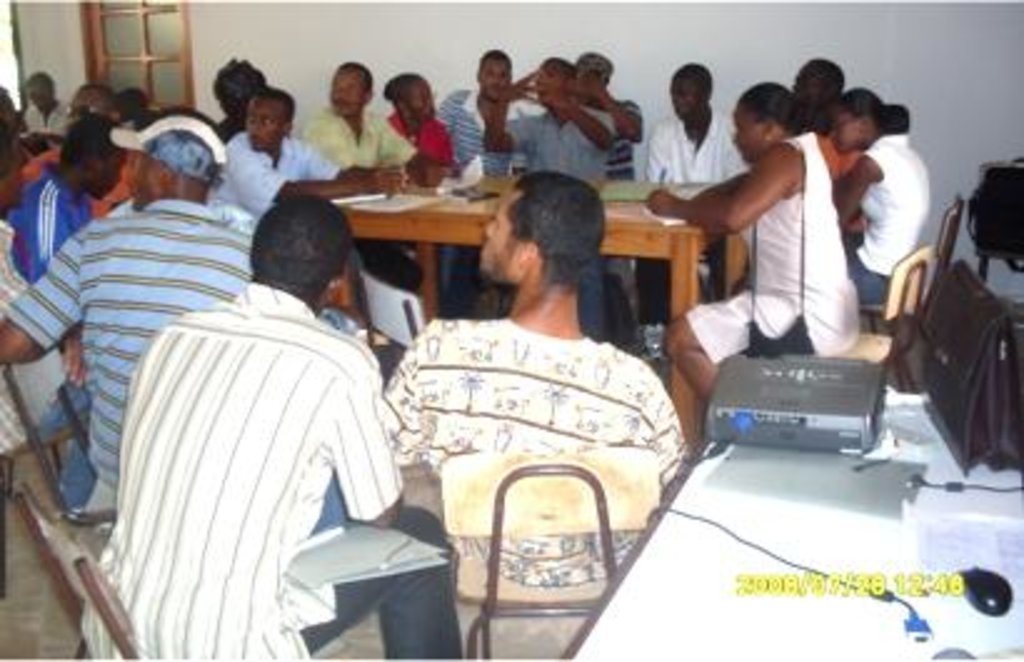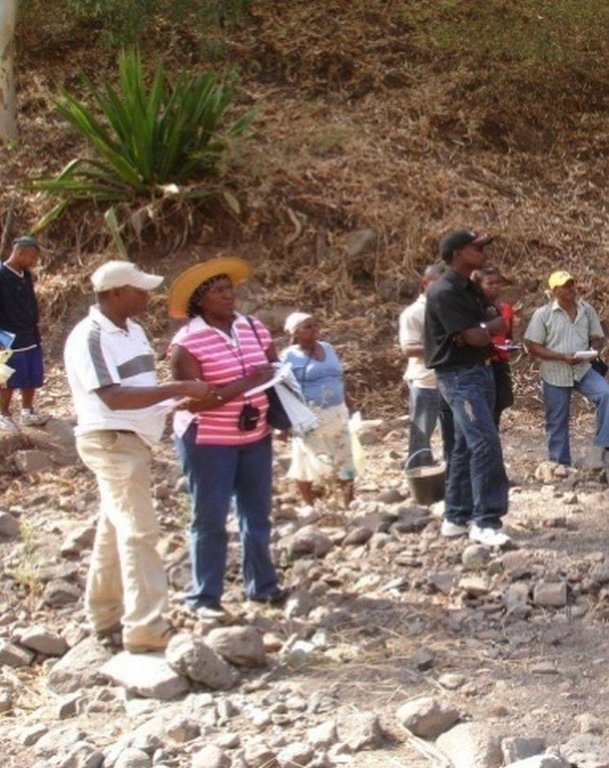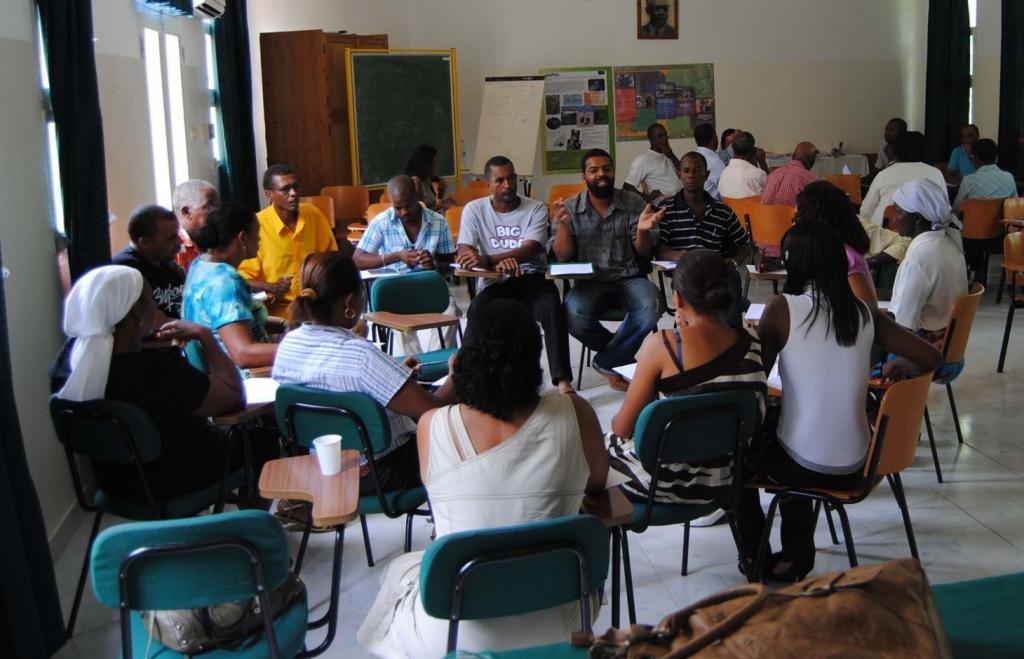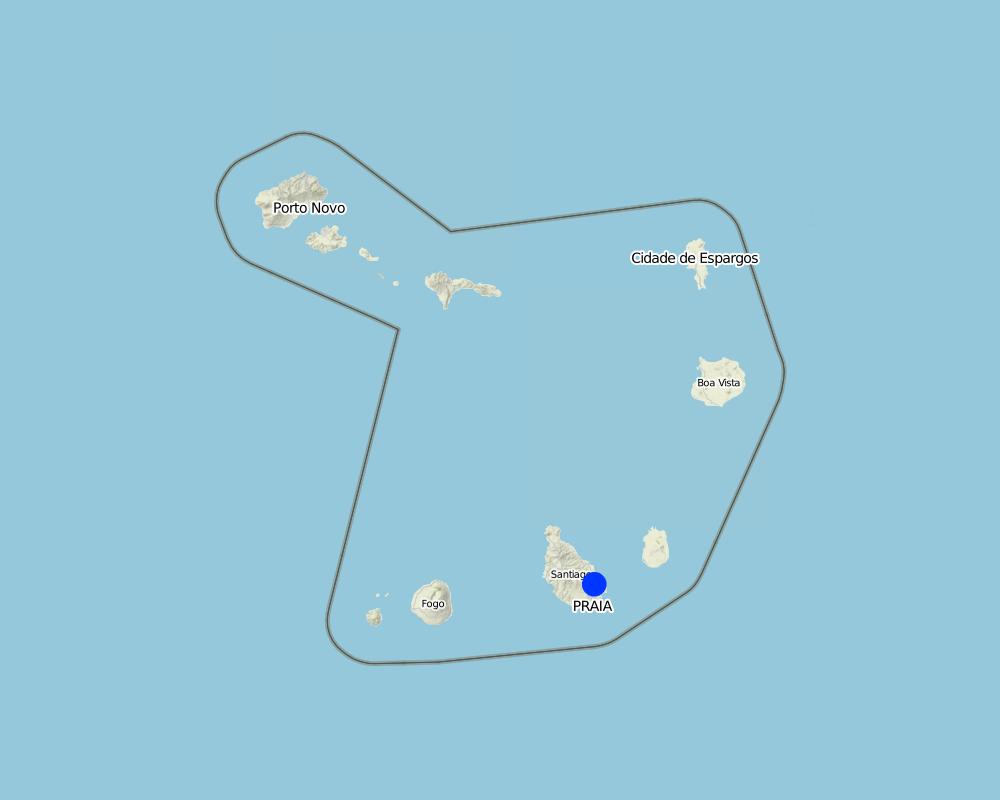Training, information and awareness raising [Cape Verde]
- Creation:
- Update:
- Compiler: Jacques Tavares
- Editor: –
- Reviewers: Fabian Ottiger, Deborah Niggli
Formação, Informação e Sensibilização (Portuguese)
approaches_2420 - Cape Verde
View sections
Expand all Collapse all1. General information
1.2 Contact details of resource persons and institutions involved in the assessment and documentation of the Approach
SLM specialist:
SLM specialist:
Lima João
+2382711127
IINIDA
São Jorge dos Órgãos, BP 84
Cape Verde
SLM specialist:
Moreno Angela
2647541
veigamoreno@hotmail.com
DGASP
São Filipe Santiago, BP 278
Cape Verde
Name of project which facilitated the documentation/ evaluation of the Approach (if relevant)
DESIRE (EU-DES!RE)Name of the institution(s) which facilitated the documentation/ evaluation of the Approach (if relevant)
INIDA (INIDA) - Cape VerdeName of the institution(s) which facilitated the documentation/ evaluation of the Approach (if relevant)
Agriculture and Forestry Directorate Cape Verde (DGASP) - Cape Verde1.3 Conditions regarding the use of data documented through WOCAT
The compiler and key resource person(s) accept the conditions regarding the use of data documented through WOCAT:
Yes
1.4 Reference(s) to Questionnaire(s) on SLM Technologies

Dams [Cape Verde]
Infrastructure of stone, mortar and concrete, built along the waterline, with the aim of retaining sediment dragged by water runoff.
- Compiler: Jacques Tavares
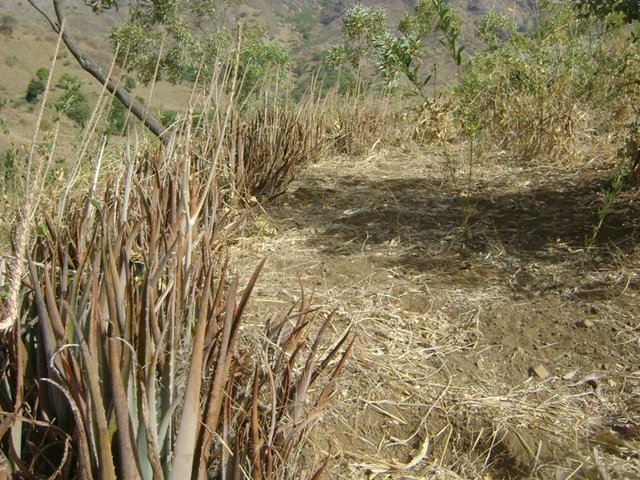
Aloe Vera Living Barriers [Cape Verde]
It is a technique which uses the structure of a cross-slope barrier of Aloe vera to combat soil erosion by decreasing surface wash and increasing infiltration.
- Compiler: Jacques Tavares
2. Description of the SLM Approach
2.1 Short description of the Approach
Integration of stakeholders in the implementation of natural resource conservation activities.
2.2 Detailed description of the Approach
Detailed description of the Approach:
Aims / objectives: Immediately after independence, the Cape Verde government initiated in collaboration with its international partners an unprecedented campaign of afforestation. Its main goal consists of fighting desertification and the drought impacts that previously produced thousands of victims and forced migration of the Cape Verde population.
Methods: Among the specific objectives are: 1) reduction of soil erosion; 2) firewood production improvement for rural families; 3) better land production; and 4) land user vulnerability mitigation.
Stages of implementation: To achieve this objective, the Cape Verde government was in need of labour provided by the population, which was easily accepted. With the financial and technical support of the government, municipalities, international projects of rural development (FAO, GTZ, etc.), NGOs (Platforms of Local and National Associations,), the technical assistance of the Rural Development Ministry (MDR) and the help of the local population, nowadays, more than 20% of the surface area of the archipelago is planted with trees. Several steps have been reached: firstly the population has been prepared (information, awareness raising and training), then reconnaissance, topographical surveys and treatments of watershed were carried out where plantations were established. It was also necessary to import seeds from many countries, to create nurseries, to treat seeds and to train Cape Verde technicians.
Role of stakeholders: The role of the population was to participate in field work, to work in collaboration with the MDR technicians, to operate the nursery and finally to transport the seedlings to the field and plant them. All these steps were achieved with the technical support of the MDR and some fund providers.
Other important information: The village suffers from substantial soil erosion, amounting to 6-10,000 tons per square km per year before the afforestation campaigns. The slopes are very steep (around 20-35 degrees). The main income of local farmers is from orchards.
2.3 Photos of the Approach
2.5 Country/ region/ locations where the Approach has been applied
Country:
Cape Verde
Region/ State/ Province:
Watershed of Ribeira Seca
Further specification of location:
Island of Santiago, Cape Verde
Map
×2.6 Dates of initiation and termination of the Approach
Indicate year of initiation:
1976
2.7 Type of Approach
- project/ programme based
2.8 Main aims/ objectives of the Approach
The Approach focused on SLM only
fight against the desertification and the drought impacts, improvement of the living standards of the local population and particularly of the rural population through vegetation and animal production increase
The SLM Approach addressed the following problems: desertification, drought, lack of water, erosion, loss of soil fertility, low soil cover, lack of firewood, loss of biodiversity,
low take-up by the local population in the management of technologies (soil and water conservation measures), the low education level of some farmers including women, and the degree of land user poverty.
2.9 Conditions enabling or hindering implementation of the Technology/ Technologies applied under the Approach
social/ cultural/ religious norms and values
- hindering
Land tenure problems and socio-economic vulnerability of rural families
Treatment through the SLM Approach: Strengthening the awareness raising activities for large land owners about land conservation to protect the long term productivity. Balancing the socio-economical gap between urban and rural communities by supporting farmers, pastoralists and associations
availability/ access to financial resources and services
- hindering
Hydraulic measures such as check dams and contour wall stones need more financial resources
Treatment through the SLM Approach: Better involvement of the donors and the State
legal framework (land tenure, land and water use rights)
- enabling
The existing land ownership, land use rights / water rights moderately helped the approach implementation: The approach moderately reduced the land/water use rights problems because managing multiple sources of irrigation water is currently the responsibility of local farmers organized in association.
- hindering
Lack of mechanisms for the implementation and the monitoring of created laws
Treatment through the SLM Approach: Boosting the local authorities (town council) and the main community associations so that they can be taken as a model.
3. Participation and roles of stakeholders involved
3.1 Stakeholders involved in the Approach and their roles
- local land users/ local communities
Single land users, pre-existing groups of land users and groups organized through the project
Generally women stay at home for the household. That is why 40% of the homes are managed by women, because men migrate to other areas or countries (women as heads of families). More than 80% of land users in Cape Verde have small incomes. Land users are involved in all the work carried out in the field implementation steps. More than 90% of the workforce comes from socially and economically disadvantaged groups.
- NGO
- national government (planners, decision-makers)
- international organization
If several stakeholders were involved, indicate lead agency:
National and state specialists with field users.
3.2 Involvement of local land users/ local communities in the different phases of the Approach
| Involvement of local land users/ local communities | Specify who was involved and describe activities | |
|---|---|---|
| initiation/ motivation | none | accelerated method of participatory research (rapid rural appraisal?), interviews/questionnaires, workshops/seminars |
| planning | none | |
| implementation | none | intermittent works, responsibilities over small steps |
| monitoring/ evaluation | none | |
| Research | none |
3.4 Decision-making on the selection of SLM Technology/ Technologies
Specify who decided on the selection of the Technology/ Technologies to be implemented:
- mainly SLM specialists, following consultation with land users
Explain:
At the beginning, decions came from specialists with consultation of local populations. However, this approach is now quite flexible because of the creation of local associations, NGOs and Municipal Commissions for Environment. Decision taken are now more structured and more consensual. Sometimes the decisions even come from the local associations
Decisions on the method of implementing the SLM Technology were made by mainly by SLM specialists with consultation of land users. For the importants works, the decisions concerning the method used are taken by specialists. But due to the excellent job done since 1975, the Ministry of Agriculture is now involved, via its Department for Rural Activities. Local populations are well trained for the implementation of soil and water conservation technologies with minimum technical support from specialists.
4. Technical support, capacity building, and knowledge management
4.1 Capacity building/ training
Was training provided to land users/ other stakeholders?
Yes
Specify who was trained:
- land users
- field staff/ advisers
- specialists of SLM, students, politician / decision maker
Form of training:
- on-the-job
- farmer-to-farmer
4.2 Advisory service
Do land users have access to an advisory service?
Yes
Specify whether advisory service is provided:
- on land users' fields
Describe/ comments:
Name of method used for advisory service: ZOPP (German Participative Approach Method); Key elements: Participative, Integrated, Practical; The extension service and rural extension are under the responsibility of delegations of Directorate General for Agriculture, Forestry and Livestock (DGASP), which are distributed over different municipalities. These delegations sometimes act as bridges between farmers and the advisory service. The extension system is very adequate to ensure continuation of activities. Ninety-nine per cent of these practices are achievable by the technicians of the government. However, dams of medium importance require external support.
Advisory service is very adequate to ensure the continuation of land conservation activities; 99% of these practices are achievable by the technicians of the government. However, dams of medium importance require external support.
4.3 Institution strengthening (organizational development)
Have institutions been established or strengthened through the Approach?
- yes, greatly
Specify the level(s) at which institutions have been strengthened or established:
- local
Specify type of support:
- financial
- capacity building/ training
- equipment
4.4 Monitoring and evaluation
Is monitoring and evaluation part of the Approach?
Yes
Comments:
bio-physical aspects were regular monitored by other through measurements; indicators: Technicians and researchers of the Ministry of Rural Development
area treated aspects were regular monitored by other through measurements; indicators: Technicians and researchers of the Ministry of Rural Development and OASIS
no. of land users involved aspects were regular monitored by other through measurements; indicators: Technicians and Researchers of the Ministry of Rural Development DGASP/ Delegations of Ministry of Rural Development/OASIS/ Platform of local Associations for Rural Development
There were several changes in the Approach as a result of monitoring and evaluation
4.5 Research
Was research part of the Approach?
Yes
Specify topics:
- sociology
- economics / marketing
- ecology
Give further details and indicate who did the research:
Research was carried out both on station and on-farm
5. Financing and external material support
5.1 Annual budget for the SLM component of the Approach
Comments (e.g. main sources of funding/ major donors):
Approach costs were met by the following donors: international (Pays-Bas, France, Belgique, USA): 50.2%; government (MADRRM): 49.8%
5.2 Financial/ material support provided to land users
Did land users receive financial/ material support for implementing the Technology/ Technologies?
Yes
5.3 Subsidies for specific inputs (including labour)
- agricultural
| Specify which inputs were subsidised | To which extent | Specify subsidies |
|---|---|---|
| seeds | fully financed | |
If labour by land users was a substantial input, was it:
- paid in cash
Comments:
Because of poverty, labour is paid.
The use of inputs depends on the type of farming system. In other words, with respect to rainfed agriculture, the purchase of seed (800 g costs about 100 escudos, about 1.20 US$) represents a general input and remains the only input that the project introduced in the agricultural fields. However, for irrigated agriculture inputs are more important, in particular fertilizers and pesticides.
5.4 Credit
Was credit provided under the Approach for SLM activities?
Yes
Specify conditions (interest rate, payback, etc.):
repayment conditions: Agricultural credit is one of the lowest in Cape Verde. This idea was born during the 1980s, several years after the Independence of Cape Verde. It all started in the framework of co-operation with the United States, in which an agency worked directly with community-based organizations with support from the government. In the 2000s, the system worked very well. The interest rate was indeed very low (less than 5%) but the amount made available to the associations or direct beneficiaries was quite limited. In 2005, within the project 'Management and Enhancement of the watersheds of Piocs and Engenhos in the Island of Santiago', agricultural credit was introduced with an interest rate of 5% for the livestock sector and irrigated agriculture. Although the number of members was limited, it worked relatively well. However, for the area of rainfed agriculture and forestry, there is no credit for the time being..
6. Impact analysis and concluding statements
6.1 Impacts of the Approach
Did the Approach help land users to implement and maintain SLM Technologies?
- No
- Yes, little
- Yes, moderately
- Yes, greatly
All shares of capacity building are oriented to both men and women and also young land users. However, the status of some women as household heads limits sometimes their participation.
Did the Approach improve issues of land tenure/ user rights that hindered implementation of SLM Technologies?
- No
- Yes, little
- Yes, moderately
- Yes, greatly
Did other land users / projects adopt the Approach?
- No
- Yes, little
- Yes, moderately
- Yes, greatly
All projects of MDR (Ministry of Rural Development) adopt this approach.
Did the Approach lead to improved livelihoods / human well-being?
- No
- Yes, little
- Yes, moderately
- Yes, greatly
Currently, the Cape Verdean agriculture presents a significant improvement over the previous decades as well as irrigated agriculture. As for rainfed agriculture, a lot of agricultural land has been reclaimed or created. However, cereal yields have increased only slightly due to the high variability of rainfall, low soil fertility and water erosion. However, the irrigated sector recorded year after year very positive results due to the improvement in the provision of surface water (with tanks, dams, etc.), the introduction of new irrigation techniques (drip irrigation), capacity building of farmers and increasing demand for garden products. These findings have resulted in a significant improvement in farmers\' income and their living conditions in a general form.
Did the Approach help to alleviate poverty?
- No
- Yes, little
- Yes, moderately
- Yes, greatly
Capacity building campaigns have played a role in the notorious burden of poverty. Many land users were able to increase their income through increased agricultural output, working as stonemasons, security guard, etc.
6.2 Main motivation of land users to implement SLM
- increased profit(ability), improved cost-benefit-ratio
The implementation of actions and works of soil and water conservation is a source of income for far
- payments/ subsidies
These associations received technical support from the Ministry of Rural Development, especially for
6.3 Sustainability of Approach activities
Can the land users sustain what has been implemented through the Approach (without external support)?
- uncertain
If no or uncertain, specify and comment:
The involvement and empowerment of community-based associations in the implementation of rural development actions intended to ensure the sustainability of these actions. Thus, the handling and monitoring of short- and medium-range actions are in the hands of intervention associations. In contrast, far-reaching actions such as hydraulic works are the responsibility of the State regarding their handling.
Some activities can be carried out without any extern support, like in example the tree and fruit species plantation, the construction of small dams, the construction of small importance tanks, the installation of a localized irrigation system.
6.4 Strengths/ advantages of the Approach
| Strengths/ advantages/ opportunities in the land user’s view |
|---|
|
Their active participation in the process |
| Strengths/ advantages/ opportunities in the compiler’s or other key resource person’s view |
|---|
|
Multidisciplinary Team Building |
|
The involvement of grassroots community associations and NGOs in the implementation of |
|
Existing decentralization (Central Authority, Local Power, Delegations of MADRRM) |
6.5 Weaknesses/ disadvantages of the Approach and ways of overcoming them
| Weaknesses/ disadvantages/ risks in the land user’s view | How can they be overcome? |
|---|---|
|
A lot of speeches and nothing concrete against |
More Actions |
|
A certain slowness between the consultation, identification and implementation phases. |
Reduce this margin |
|
Not enough money to support their agrarian problems |
Synergy and co-operation between rural development programs and projects. |
| Weaknesses/ disadvantages/ risks in the compiler’s or other key resource person’s view | How can they be overcome? |
|---|---|
|
Low exchange between island operators |
Creating funds capable of supporting trade between operators of the main agricultural islands |
|
Santiago continues to be the most favored island compared to others. |
Programs should be more integrated and inclusive |
|
High rural poverty |
Enhancing Poverty Reduction Programs |
|
Lack of land |
Establish programs for the conversion of certain lands and forests |
|
Land tenure in place |
Integrate the church more into the land issue, as this religious institute has a large share of agricultural land. |
7. References and links
7.1 Methods/ sources of information
- field visits, field surveys
- interviews with land users
7.2 References to available publications
Title, author, year, ISBN:
And Emilia, V., 1995. Diagnostico inicial junto da comunidade. Volume II, Guia Para o Formador. Minstério de Agricultura-Projecto GCP/CVI/032/ITA “ Consolidação das actividades do Centro de Formação de São Jorge”, pp 99.
Available from where? Costs?
Bibliothèque INIDA
Title, author, year, ISBN:
Le Sahel en Lutte contre la Désertification, RENE MARCEAU ROCHETTE, 1989
Available from where? Costs?
Bibliothèque INIDA
Title, author, year, ISBN:
ESTUDO DA ABORDAGEM UTILIZADA PELO DESIRE NA PROBLEMÁTICA DE DEGRADAÇÃO E DESERTIFICAÇÃO DAS TERRAS NA BACIA HIDROGRÁFICA DA RIBEIRA SECA
Available from where? Costs?
Bibliothèque CFA_INIDA
Title, author, year, ISBN:
Ciclo de capacitação dos agentes de apoio a reforma agrária, Osvaldo Cruz, 1987
Available from where? Costs?
Bibliothèque INIDA
Title, author, year, ISBN:
www.desire-his.eu/en/ribeira-seca-cape-verde
Available from where? Costs?
Bibliothèque INIDA
Links and modules
Expand all Collapse allLinks

Dams [Cape Verde]
Infrastructure of stone, mortar and concrete, built along the waterline, with the aim of retaining sediment dragged by water runoff.
- Compiler: Jacques Tavares

Aloe Vera Living Barriers [Cape Verde]
It is a technique which uses the structure of a cross-slope barrier of Aloe vera to combat soil erosion by decreasing surface wash and increasing infiltration.
- Compiler: Jacques Tavares
Modules
No modules


